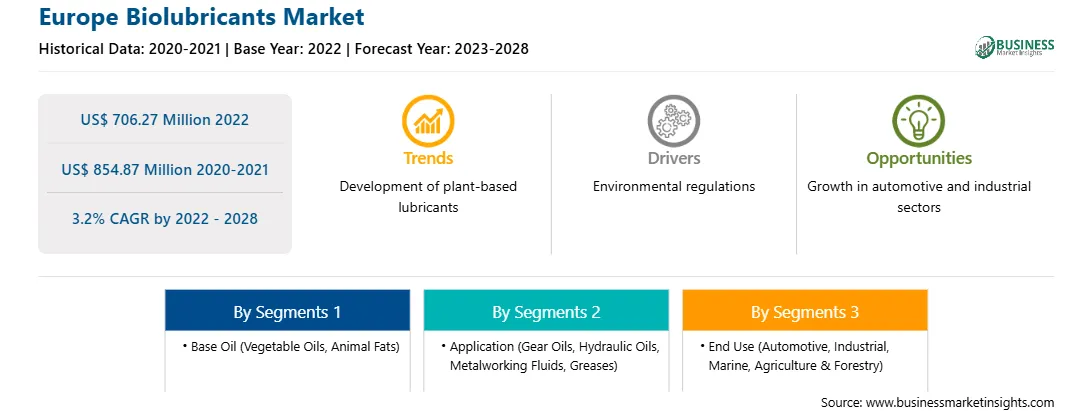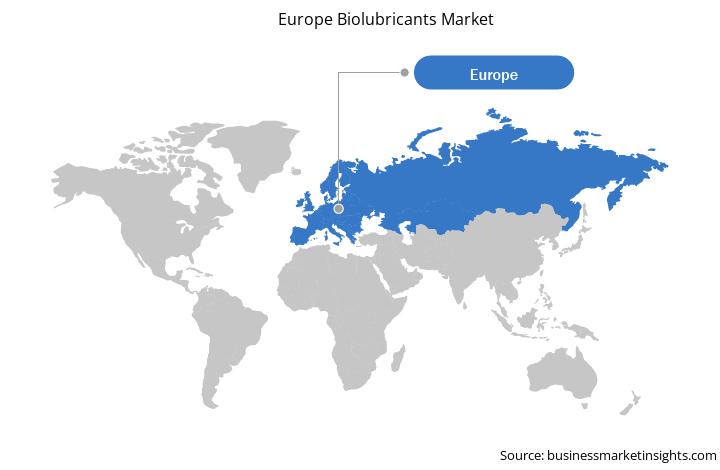The Europe biolubricants market is expected to grow from US$ 706.27 million in 2022 to US$ 854.87 million by 2028. It is estimated to register a CAGR of 3.2% from 2022 to 2028.
Surging Demand for Bio-Based and Sustainable Products in Various Industries Drives Europe Biolubricants Market
In the industrial sector, lubricant is one of the key components that help an equipment operate with maximum reliability and at peak efficiency. Bio-based, mineral, and synthetic lubricants; greases; compressor oils; cutting fluids; and other lubricants contain additives. Lubricants are used across various industries, including automotive, oil & gas, textile, glass, power generation, paper & pulp, chemicals & petrochemicals, agriculture, manufacturing, food & beverages, and pharmaceuticals. Mineral and synthetic lubricants pollute the environment in small but extensive quantities. Most of these lubricants are nonaqueous liquids. Earlier, almost all lubricants were mineral oil-based products. Also, they can cause major environmental damage due to accidental spillage, improper disposal, leakages, and lost lubrication. Increasing environmental and climate-protection directives ensure robust demand for bio-based products in a handful of high-growth, specialty-product categories. Environmental compatibility, longer product life, and high performance have driven the shift from traditional mineral oil lubricants to synthetic and quasi-synthetic oils and biolubricants. Conventional mineral-based lubricants can adversely affect the operators' health and the environment. Also, several studies have proven that these lubricants may contain carcinogenic additives and impurities in their formulation, which causes dermatitis and skin cancer. Furthermore, mineral oil is inferior in biodegradability, with a range of 15–35% biodegradation. The said biodegradation values are below the accepted guideline for environmentally acceptable lubricant, 80%. Therefore, plant oil has been preferred to conventional mineral-based lubricants.
In addition, strong environmental concerns and growing regulations over contamination and pollution in the environment have increased the need for renewable and biodegradable lubricants. Accelerating research and development in this area has also been driven by public demand, industrial concern, and government agencies. Better ways to protect the ecosystem or reduce the negative impact of spills or leakage of lubricants must be outlined. Governments of various countries have imposed regulations to increase the usage of bio-based products. French law 2010-788 (12/7/2010) prohibits, in natural areas classified as "sensitive," the use of fossil-based lubricants, which can be easily substituted with biodegradable nonecotoxic lubricants that meet the criteria for the European Ecolabel (2005/360/EC directive). These favorable regulations propel the demand for bio-based and sustainable biolubricants in various industries.
Europe Biolubricants Market Overview
The European Union’s Registration, Evaluation, Authorization and Restriction of Chemicals (REACH) is thought to be the most important legislation to aid the development of biolubricants. REACH has been implemented to clean up the chemical industry and reduce the use of toxic substances. In addition to the environmental reasons, the increase in the cost of crude oil, along with concerns around the security of supply, gives a long-term financial incentive to switch to biolubricants. Nordic countries, including Denmark, Sweden, Finland, and Norway, are more proactively adopting biolubricants regardless of regulations, given the elevated collective environmental awareness in those countries. In France, institutional policies such as the Agriculture Guidance Law and the retirement and occupational health funds have been essential in promoting biolubricants, especially in applications with high worker exposure, like metalworking fluids. Furthermore, the growing automotive industry in the region is boosting the biolubricants growth. The automobile industry is one of the most rapidly growing and important industries in the European economy. According to the European Commission (EU), Europe is among the world's largest producers of motor vehicles. The automobile industry employs 13.8 million Europeans directly and indirectly, accounting for 6.1% of overall employment in the EU. According to the International Organization of Motor Vehicle Manufacturers (OICA), the EU produced 13.0 million vehicles in 2021. Biolubricants’ primary use is to reduce wear and friction on moving parts while cleaning the engine varnish and sludge. In Europe, the demand for passenger cars is heavily influenced by economic conditions. The demand for biolubricants in Europe is anticipated to grow significantly during the forecast period.
Europe Biolubricants Market Revenue and Forecast to 2028 (US$ Million)
Strategic insights for the Europe Biolubricants provides data-driven analysis of the industry landscape, including current trends, key players, and regional nuances. These insights offer actionable recommendations, enabling readers to differentiate themselves from competitors by identifying untapped segments or developing unique value propositions. Leveraging data analytics, these insights help industry players anticipate the market shifts, whether investors, manufacturers, or other stakeholders. A future-oriented perspective is essential, helping stakeholders anticipate market shifts and position themselves for long-term success in this dynamic region. Ultimately, effective strategic insights empower readers to make informed decisions that drive profitability and achieve their business objectives within the market. The geographic scope of the Europe Biolubricants refers to the specific areas in which a business operates and competes. Understanding local distinctions, such as diverse consumer preferences (e.g., demand for specific plug types or battery backup durations), varying economic conditions, and regulatory environments, is crucial for tailoring strategies to specific markets. Businesses can expand their reach by identifying underserved areas or adapting their offerings to meet local demands. A clear market focus allows for more effective resource allocation, targeted marketing campaigns, and better positioning against local competitors, ultimately driving growth in those targeted areas.
Europe Biolubricants Strategic Insights

Europe Biolubricants Report Scope
Report Attribute
Details
Market size in 2022
US$ 706.27 Million
Market Size by 2028
US$ 854.87 Million
Global CAGR (2022 - 2028)
3.2%
Historical Data
2020-2021
Forecast period
2023-2028
Segments Covered
By Base Oil
By Application
By End Use
Regions and Countries Covered
Europe
Market leaders and key company profiles
Europe Biolubricants Regional Insights

Europe Biolubricants Market Segmentation
The Europe biolubricants market is divided into base oil, application, end use, and country.
Based on base oil, the Europe biolubricants market is segmented into vegetable oils, animal fats, and others. The vegetable oils segment held the largest Europe biolubricants market share in 2022.
Based on application, the Europe biolubricants market is segmented into gear oils, hydraulic oils, metalworking fluids, greases, and others. The others segment held the largest Europe biolubricants market share in 2022.
Based on end use, the Europe biolubricants market is segmented into automotive, industrial, marine, agriculture & forestry, and others. The industrial segment held the largest Europe biolubricants market share in 2022.
Based on country, the Europe biolubricants market is segmented into Germany, France, Italy, the UK, Russia, and the Rest of Europe. The Rest of Europe dominated the Europe biolubricants market in 2022.
Carl Bechem GmbH, Emery Oleochemicals LLC, Fuchs Petrolub SE, Kluber Lubrication GmbH & Co KG, Panolin AG, Shell Plc, and TotalEnergies SE are among the leading companies operating in the Europe biolubricants market.
The Europe Biolubricants Market is valued at US$ 706.27 Million in 2022, it is projected to reach US$ 854.87 Million by 2028.
As per our report Europe Biolubricants Market, the market size is valued at US$ 706.27 Million in 2022, projecting it to reach US$ 854.87 Million by 2028. This translates to a CAGR of approximately 3.2% during the forecast period.
The Europe Biolubricants Market report typically cover these key segments-
The historic period, base year, and forecast period can vary slightly depending on the specific market research report. However, for the Europe Biolubricants Market report:
The Europe Biolubricants Market is populated by several key players, each contributing to its growth and innovation. Some of the major players include:
The Europe Biolubricants Market report is valuable for diverse stakeholders, including:
Essentially, anyone involved in or considering involvement in the Europe Biolubricants Market value chain can benefit from the information contained in a comprehensive market report.